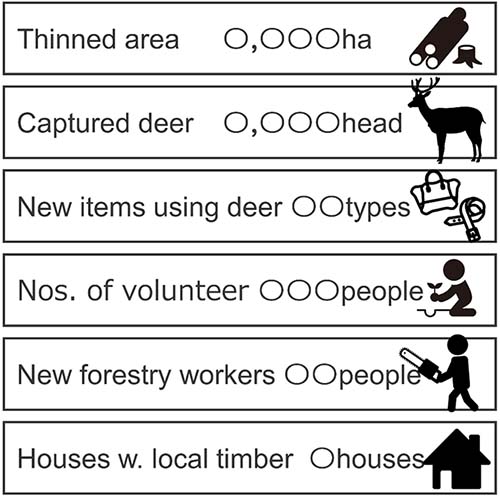Home > Research > Research Results > Research Results 2019 > Forestry management indicators represent the state of forests in the city
Update:October 16, 2019
Main content starts here.
Forestry management indicators represent the state of forests in the city
| Article title |
The means and problems of establishing indicators for municipal governments in forest planning |
|---|---|
| Author (affiliation) |
Yusuke Yamada (a) (a) Department of Forest management, FFPRI, Tsukuba, Ibaraki, Japan. |
| Publication Journal |
Japanese Journal of Forest Planning, 52(2):49-57, April 2019 DOI:10.20659/jjfp.52.2_49( External link ) |
| Content introduction |
In forestry management, target values such as thinned areas are listed as “indicators” and the degree of target achievement can be evaluated by comparing them with the actual values (see figure). Indicators are also expected to be used in forestry management on the regional level. Some municipalities use indicators for the purpose of forestry management. Therefore, we surveyed advanced cities that use indicators in forestry management for identifying and comparing the characteristics and issues of the indicators in these cities. The results of this survey revealed that not only administrative, academic, and forestry personnel but also residents participated in forestry management planning in these advanced cities. By incorporating the opinions of the people involved, the indicators of each city were formed in a bottom-up manner and precisely reflected the local characteristics and circumstances. Because their foci were only visible problems, the multifaceted functions of the forest could not be reflected only by this set of visible indicators. This was a problem common to all cities surveyed. In addition, each city was struggling in disseminating information pertaining to these plans and indicators to the residents. Under these circumstances, we found that some cities made efforts to raise interest in their plans, such as setting indicators directly related to the lives of the residents. To utilize the indicators more efficiently in forestry management in municipalities, further research is required to solve the identified issues in cooperation with people in the actual field sites.
Figure: Examples of indicators used for municipal forestry management |
Copyright © Forest Research and Management Organization. All rights reserved.

